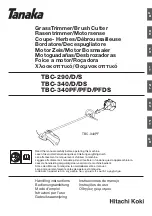
7
3.
While securely holding the upper shaft,
pull the attachment straight out of the
coupler.
INSTALLING OPTIONAL ATTACH-
MENTS
1.
Remove the shaft cap from the attach-
ment (if present) and discard.
2.
Position locking/release button of attach-
ment into guide recess of upper shaft
coupler.
Coupler Primary Hole
Upper
Shaft
Locking/
Release
Button
Attachment
Guide Recess
3.
Push the attachment into the coupler until
the locking/release button snaps into the
primary hole.
4.
Before using the unit, tighten the knob se-
curely by turning clockwise.
INSTALLING ATTACHMENT
HANGER
An attachment hanger is provided for storage
when attachment is not in use. To install hang-
er on attachment:
1.
Remove the shaft cap from the attach-
ment (if present) and discard.
2.
Press and hold the locking/release but-
ton.
3.
Push hanger onto the attachment until
the locking/release button snaps into the
hole.
OPERATING POSITION
Boots
Heavy,
Long Pants
Eye Protection
ALWAYS WEAR:
Cut from your left to your right.
NOTE:
This brushcutter attachment is not
designed for use with electric powerheads.
When operating unit with brushcutter attach-
ment, clip shoulder strap onto upper shoulder
strap clamp, stand as shown and check for the
following:
S
Wear eye protection and heavy clothing.
S
Keep arms extended with right hand holding
the trigger handle of powerhead.
S
Keep left arm extended with left hand hold-
ing the handlebar.
S
Keep unit below waist level.
S
Shoulder strap pad should be centered on
your left shoulder and danger sign centered
on your back.
S
Maintain full weight of tool on left shoulder.
S
Without bending over, keep the blade near
and parallel to the ground and not crowded in-
to material being cut.
OPERATING INSTRUCTIONS FOR
BRUSHCUTTER ATTACHMENT
S
Blade Thrust is a reaction that only occurs
when using a bladed unit. This reaction can
cause serious injury such as amputation.
Carefully study this section. It is important that
you understand what causes blade thrust,
how you can reduce the chance of its occur-
ring, and how you can remain in control of unit
if blade thrust occurs.
S
WHAT CAUSES BLADE THRUST -- Blade
Thrust can occur when spinning blade con-
tacts an object that it does not cut. This contact
causes blade to stop for an instant and then
suddenly move or “thrust” away from object
that was hit. The “thrusting” reaction can be
violent enough to cause operator to be pro-
pelled in any direction and lose control of unit.
The uncontrolled unit can cause serious injury
if blade contacts operator or others.
S
WHEN BLADE THRUST OCCURS --
Blade Thrust can occur without warning if
the blade snags, stalls, or binds. This is
more likely to occur in areas where it is diffi-
cult to see the material being cut. By using
the unit properly, the occurrence of blade
thrust will be reduced and the operator will
be less likely to lose control.
S
Cut only grass, weeds, and woody brush up to
1/2 inch (1 cm) in diameter with weed blade.
Do not let blade contact material it cannot cut
such as stumps, rocks, fences, metal, etc., or
clusters of hard, woody brush with a diameter
greater than 1/2 inch (1 cm).
S
Use a sharp blade. A dull blade is more likely
to snag and thrust.
S
Cut only at full throttle. The blade will have
maximum cutting power and is less likely to
bind or stall.
S
“Feed” the blade deliberately and not too
rapidly. The blade can thrust away if it is fed
too rapidly.
S
Cut only from your left to your right. Cutting on
right side of the shield will throw debris away
from the operator.
S
Use the shoulder strap and keep a firm grip
on the unit with both hands. A properly ad-
justed shoulder strap will support the weight
of the unit, freeing your arms and hands to
control and guide the cutting motion.
S
Keep feet comfortably spread apart and
braced for a possible sudden, rapid thrust of
unit. Do not overreach. Keep firm footing and
balance.




























